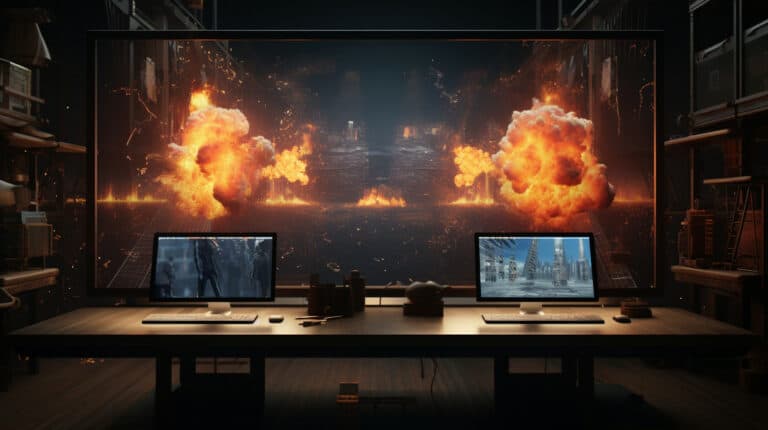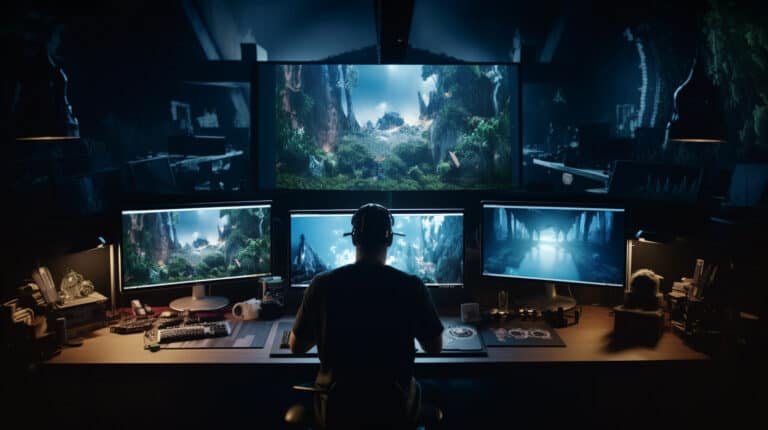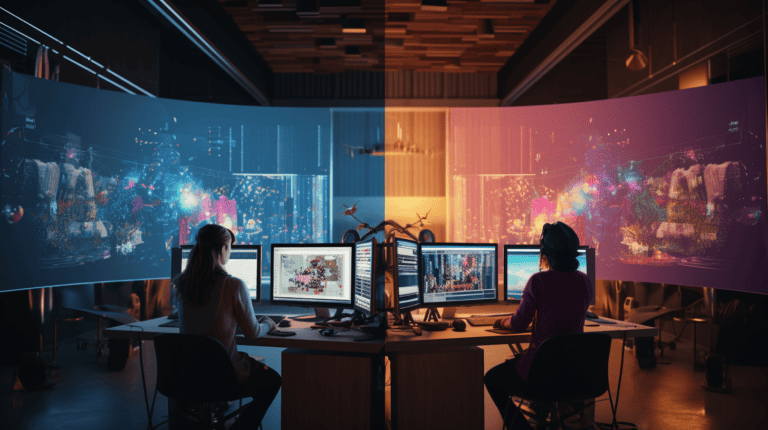What Does a Visual Effects Producer Do?
Do you ever wonder what a visual effects producer does? They are the ones responsible for bringing the magic to the big screen. From coordinating complex special effects to managing budgets and timelines, a visual effects producer plays a crucial role in the filmmaking process.
In this article, we will explore the responsibilities, skills, and challenges faced by visual effects producers, as well as the exciting career opportunities that await them in the industry.
Get ready to delve into the world of visual effects production!
Key Takeaways
- Visual effects producers oversee the integration of computer-generated imagery into visual storytelling, enhancing the overall viewing experience and bringing imagination to life.
- They collaborate with directors, cinematographers, and visual effects artists to create stunning visuals, realistic environments, and mind-blowing special effects.
- Their role involves managing the production pipeline, coordinating resources, and meeting deadlines, as well as budgeting and scheduling to allocate resources effectively.
- Visual effects producers play a pivotal role in shaping the final look and feel of the film by coordinating efforts with the post-production team and ensuring timely delivery of the final visual effects.
Introduction to Visual Effects Production
Visual effects are the magic that brings imagination to life on the big screen. As a visual effects producer, you play a crucial role in making sure that these effects seamlessly blend with the live-action footage.
From creating fantastical creatures to breathtaking environments, visual effects have become an integral part of modern filmmaking, enhancing the storytelling experience in ways that were once unimaginable.
Definition of Visual Effects
Producing visual effects involves overseeing the creation and integration of computer-generated imagery into film and television productions. Visual effects are the digital enhancements that bring imagination to life on screen. They can range from simple adjustments like color grading to complex creations like fantastical creatures or out-of-this-world environments.
Visual effects can be used to enhance the realism of a scene, create elements that are impossible to capture in real life, or transport the audience to extraordinary worlds. It requires a combination of artistic creativity, technical expertise, and meticulous attention to detail.
Visual effects are an essential part of modern filmmaking, allowing filmmakers to push the boundaries of storytelling and create immersive experiences for audiences.
Role of Visual Effects in Film and Television
As a visual effects producer, you play a crucial role in the production of film and television by overseeing the integration of computer-generated imagery (CGI) into the visual storytelling process.
Visual effects have become an integral part of modern filmmaking, allowing creators to bring their imagination to life and enhance the overall viewing experience. Through the skillful use of CGI, you have the power to create stunning visuals, realistic environments, and mind-blowing special effects that captivate audiences and transport them to new worlds.
Your role involves working closely with directors, cinematographers, and visual effects artists to ensure that the visual effects seamlessly blend with the live-action footage and serve the story. By managing the production pipeline, coordinating resources, and ensuring deadlines are met, you contribute to the successful execution of visual effects in film and television.
Responsibilities of a Visual Effects Producer
As a visual effects producer, your responsibilities span across the three main phases of production: pre-production, production, and post-production.
In the pre-production phase, you work closely with the director and other key stakeholders to plan and budget for the visual effects needed in the film.
During the production phase, you oversee the execution of the visual effects shots, ensuring that they align with the creative vision.
Pre-production Phase
As a visual effects producer, your role in the pre-production phase is crucial for the successful implementation of visual effects in a film.
You’ll collaborate closely with directors and producers to understand their vision and help develop a plan for incorporating visual effects seamlessly into the story.
Additionally, you’ll be responsible for budgeting and scheduling, ensuring that the necessary resources are allocated effectively.
Collaborating with Directors and Producers
When collaborating with directors and producers during the pre-production phase, you’ll need to reach out and establish clear communication channels. This is crucial for ensuring that everyone is on the same page and that the vision for the visual effects is understood.
You’ll need to actively listen to their ideas and concerns, while also offering your expertise and suggestions. Building a strong working relationship with the creative team is essential for a successful visual effects production.
Budgeting and Scheduling
To effectively manage the budget and schedule during the pre-production phase, you’ll need to carefully allocate resources and create a detailed timeline for the visual effects production.
This crucial responsibility requires meticulous planning and organization. As a visual effects producer, you must consider the financial constraints, negotiate contracts, and balance the needs of the project with the available resources.
Hiring and Managing the Visual Effects Team
Once you have allocated resources and created a detailed timeline, it’s time to hire and manage the visual effects team for the pre-production phase of your project.
Hiring the right team members is crucial for the success of your project. Look for individuals with the necessary skills and experience in visual effects.
Once the team is formed, effective management is key. Provide clear expectations, regular communication, and support to ensure a smooth and efficient workflow.
Production Phase
During the production phase, as a visual effects producer, you’ll be responsible for overseeing the execution of visual effects shots, ensuring that they align with the director’s vision.
Your role will involve constant communication with the director and the production team, ensuring that everyone is on the same page and that the visual effects are integrated seamlessly into the film.
Additionally, you’ll need to be adept at troubleshooting and problem-solving, as issues may arise during the production process that require quick thinking and creative solutions.
Overseeing the Execution of Visual Effects Shots
You will oversee the execution of visual effects shots as a visual effects producer during the production phase. This involves ensuring that the shots align with the director’s vision and meet the quality standards.
As you guide the process, you’ll face challenges such as managing tight deadlines, coordinating with various teams, and troubleshooting technical issues.
The responsibility of delivering captivating visual effects shots rests on your shoulders, but the satisfaction of seeing the final product come to life makes it worthwhile.
Communicating with the Director and Production Team
As a visual effects producer during the production phase, your responsibility includes maintaining effective communication with the director and production team. This involves conveying the director’s vision for the visual effects, discussing any technical limitations or challenges, and ensuring that the production team has all the necessary information to execute the desired effects. Clear and open communication is essential to ensure that everyone is on the same page and that the visual effects align with the overall creative vision of the project.
| Responsibilities of a Visual Effects Producer: Production Phase |
|---|
| * Convey the director’s vision for visual effects |
| * Discuss technical limitations and challenges |
| * Provide necessary information to the production team |
| * Ensure visual effects align with the overall creative vision |
Troubleshooting and Problem-solving
To effectively troubleshoot and solve problems as a visual effects producer during the production phase, you must anticipate and address technical challenges that may arise. This requires a keen eye for detail and the ability to think quickly on your feet.
As a visual effects producer, you’re responsible for ensuring that all visual effects elements seamlessly integrate into the final product. This involves troubleshooting issues such as mismatched lighting, color inconsistencies, and rendering errors.
Post-production Phase
As a visual effects producer in the post-production phase, you play a critical role in reviewing and approving visual effects shots.
You work closely with the post-production team, coordinating their efforts to ensure the timely delivery of the final visual effects.
Reviewing and Approving Visual Effects Shots
You will review and approve visual effects shots as a visual effects producer during the post-production phase. This crucial responsibility allows you to ensure that the shots align with the artistic vision and technical requirements of the project. With each shot, you have the power to shape the final look and feel of the film, immersing the audience in a breathtaking visual experience.
Next, you’ll coordinate with the post-production team to bring these approved shots to life seamlessly.
Coordinating with Post-production Team
Coordinate with the post-production team to ensure a seamless execution of the approved visual effects shots.
As a visual effects producer, you play a crucial role in overseeing the final stages of the production process.
Collaborate closely with editors, colorists, sound designers, and other members of the post-production team to ensure that the visual effects seamlessly integrate with the overall vision of the project.
Effective communication and efficient coordination are key to delivering a high-quality final product.
Ensuring Timely Delivery of Final Visual Effects
To ensure timely delivery of final visual effects, it’s important for a visual effects producer to closely monitor the progress of the post-production team and actively collaborate with them.
This phase is crucial in bringing the vision to life. The producer must navigate challenges, such as tight deadlines and technical issues, while maintaining clear communication and managing expectations.
Their role is to ensure that the final visual effects meet the highest standards and are delivered on time, leaving a lasting impact on the audience.
Skills and Qualifications of a Visual Effects Producer
To succeed as a visual effects producer, you need technical knowledge of the software and tools used in the industry. This includes being proficient in programs like Maya, Nuke, and After Effects.
Additionally, project management and organizational skills are crucial in order to effectively oversee the production process and ensure deadlines are met.
Lastly, strong communication and collaboration skills are essential for working with a team of artists, animators, and other professionals involved in the visual effects process.
Technical Knowledge of Visual Effects Software and Tools
As a Visual Effects Producer, your proficiency in utilizing industry-standard visual effects software and tools is crucial to successfully overseeing the production of visual effects in film and television projects. To excel in this role, you must possess a deep understanding and technical knowledge of the software and tools used in the visual effects industry.
Here are some key points to consider:
- Mastery of software: Having expertise in software such as Adobe After Effects, Autodesk Maya, and Nuke is essential for creating and manipulating visual effects.
- Understanding of rendering engines: Knowledge of rendering engines like Arnold or V-Ray allows you to optimize the rendering process and achieve high-quality results.
- Compositing skills: Being skilled in compositing techniques and software like Blackmagic Fusion or Foundry Nuke enables you to seamlessly integrate visual effects into live-action footage.
- Problem-solving abilities: Having the ability to troubleshoot and find creative solutions when faced with technical challenges is crucial for a successful visual effects producer.
With a strong technical foundation, you can effectively manage and lead visual effects teams, ensuring the delivery of exceptional visual effects in your projects.
Project Management and Organizational Skills
Once you have mastered the technical knowledge of visual effects software and tools, it’s essential to develop strong project management and organizational skills as a Visual Effects Producer.
In this role, you’ll be responsible for overseeing the entire visual effects production process, from start to finish. This includes coordinating with various departments, managing budgets and timelines, and ensuring that all tasks are completed on schedule.
Effective project management skills are crucial to keep the production running smoothly and to meet client expectations. Additionally, strong organizational skills are necessary to keep track of multiple projects, deadlines, and resources.
As a Visual Effects Producer, your ability to effectively manage and organize projects will play a vital role in the success of the visual effects production.
Communication and Collaboration Skills
Developing strong communication and collaboration skills is crucial for a Visual Effects Producer. As you work closely with various departments and stakeholders throughout the visual effects production process, effective communication ensures that everyone is on the same page and understands their roles and responsibilities. Collaboration allows for the exchange of ideas and fosters a creative and productive work environment.
These skills can make or break a project, as they determine the success of team dynamics. By effectively communicating and collaborating, you can build strong relationships with your team members, create a positive work atmosphere, and ultimately deliver high-quality visual effects.
Challenges Faced by Visual Effects Producers
As a visual effects producer, you have to navigate the challenges of managing tight deadlines and budget constraints. You’re responsible for ensuring that the project is completed on time and within the allocated resources.
Additionally, you must find a way to balance the creative vision of the director with the practical limitations of the technology and resources available.
Lastly, unexpected changes and revisions are inevitable in the post-production process, and it’s your job to handle them effectively and efficiently.
Managing Tight Deadlines and Budget Constraints
To effectively navigate the challenges of managing tight deadlines and budget constraints, visual effects producers must carefully prioritize tasks and make strategic decisions. It requires a combination of creativity, resourcefulness, and strong project management skills.
Here are four key strategies that can help visual effects producers overcome these challenges:
- Streamline workflows: By finding efficient ways to streamline workflows and eliminate unnecessary steps, producers can save valuable time and resources.
- Effective communication: Clear and open communication with the entire team is essential to ensure everyone is on the same page and working towards the same goal.
- Flexibility and adaptability: Being able to adapt to unexpected changes and adjust plans accordingly is crucial when working under tight deadlines and budget constraints.
- Creative problem-solving: Visual effects producers often need to think outside the box and find innovative solutions to overcome obstacles and meet project requirements.
Balancing Creative Vision with Practical Limitations
Balancing creative vision with practical limitations presents significant challenges for visual effects producers.
As a visual effects producer, you’re constantly tasked with bringing the director’s creative vision to life while navigating the constraints of budget, time, and technology.
It requires a delicate balance between pushing the boundaries of what’s possible and managing the expectations of the stakeholders.
You must be able to communicate effectively with the creative team, understanding their vision and finding innovative solutions to achieve it within the given limitations.
Additionally, you need to stay up-to-date with the latest advancements in technology and software, ensuring that you have the tools necessary to execute the creative vision effectively.
It’s a constant juggling act, but when done successfully, it can result in breathtaking visual effects that enhance the overall cinematic experience.
Dealing with Unexpected Changes and Revisions
When unexpected changes and revisions arise, visual effects producers frequently encounter new challenges in bringing the director’s creative vision to life. These challenges can be both frustrating and exhilarating, as they push the boundaries of what’s possible in visual effects production.
Here are some of the emotions that visual effects producers may experience when faced with unexpected changes and revisions:
- Anxiety: The pressure to deliver high-quality work within tight deadlines can be overwhelming.
- Excitement: The opportunity to find creative solutions to unexpected challenges can be invigorating.
- Frustration: Dealing with constant changes and revisions can be mentally and emotionally draining.
- Satisfaction: Successfully overcoming unexpected challenges and delivering exceptional visual effects can be incredibly rewarding.
In the face of these challenges, visual effects producers must remain flexible, adaptable, and resourceful to ensure the director’s creative vision is realized.
Collaboration with Other Professionals in the Film Industry
When working as a visual effects producer, you’ll find yourself collaborating with a variety of professionals in the film industry.
This includes working closely with directors and producers to understand their vision and ensure that the visual effects align with the overall goals of the project.
Additionally, you’ll coordinate with visual effects supervisors and artists to translate these ideas into reality, and collaborate with post-production and sound design teams to seamlessly integrate the visuals into the final product.
Working with Directors and Producers
Collaborate closely with directors and producers in the film industry as a visual effects producer, ensuring the seamless integration of visual effects into the overall vision of the project. Your role is pivotal in bringing their creative ideas to life through the use of cutting-edge technology and artistic expertise.
As a visual effects producer, you work alongside directors and producers to understand their vision and goals for the project. By fostering open communication and collaboration, you help shape the visual effects to enhance the storytelling and amplify the emotions evoked by the film.
Here are four key ways you collaborate with directors and producers:
- Translating their vision: You listen attentively to their ideas and translate them into actionable visual effects concepts.
- Providing creative solutions: You offer innovative ideas and solutions to overcome challenges and achieve the desired visual impact.
- Managing expectations: You establish clear timelines, budgets, and deliverables to ensure a smooth production process.
- Facilitating collaboration: You serve as a bridge between the creative and technical teams, facilitating effective communication and collaboration.
Coordinating with Visual Effects Supervisors and Artists
Coordinate with visual effects supervisors and artists to ensure seamless collaboration with other professionals in the film industry as a visual effects producer. As a visual effects producer, your role is not just limited to overseeing the production process, but also involves working closely with other professionals to bring the director’s vision to life. The table below highlights the key responsibilities and collaborations you can expect in this role:
| Responsibility | Collaboration |
|---|---|
| Pre-production planning | Work with visual effects supervisor and artists to develop a plan |
| Budget management | Coordinate with production accountant to allocate funds |
| Resource allocation | Collaborate with production manager to assign resources |
| Communication | Regularly update the director and producers on progress |
| Problem-solving | Work closely with visual effects artists to address any challenges |
Collaborating with Post-production and Sound Design Teams
To collaborate effectively with other professionals in the film industry, the visual effects producer must work closely with the post-production and sound design teams. This collaboration is essential for creating a seamless integration of visual effects and sound in a film. Here are four reasons why this collaboration is crucial:
- Enhancing the storytelling: By collaborating with the post-production and sound design teams, the visual effects producer can ensure that the visual effects and sound elements align with the overall narrative and enhance the storytelling experience for the audience.
- Creating immersive environments: The combination of visual effects and sound design can transport the audience into immersive worlds, creating a more engaging and captivating cinematic experience.
- Achieving technical coherence: Collaborating with post-production and sound design teams allows for technical coherence, ensuring that the visual effects and sound seamlessly blend together without any inconsistencies.
- Elevating the emotional impact: Visual effects and sound design can work together to evoke specific emotions in the audience, enhancing the overall impact of the film.
Career Path and Opportunities for Visual Effects Producers
Curious about the career path and opportunities available for visual effects producers?
Let’s explore the education and training requirements, entry-level positions, and advancement opportunities in this exciting field.
We’ll also take a look at the job prospects and industry growth, giving you a glimpse into the potential future of visual effects production.
Education and Training Requirements
To become a visual effects producer, you’ll need to pursue a specialized education and training in the field. Here are a few key points to consider:
- Formal Education: Many visual effects producers have a bachelor’s degree in a related field such as film, animation, or visual effects. This provides a strong foundation of knowledge and skills necessary for the role.
- Hands-on Experience: In addition to formal education, gaining practical experience through internships or entry-level positions can be invaluable. This allows you to apply what you have learned in a real-world setting and build a portfolio of work.
- Continuing Education: The field of visual effects is constantly evolving, so it’s important to stay up-to-date with the latest software, techniques, and industry trends. Taking workshops, attending conferences, and participating in online courses can help you stay current and enhance your skills.
- Networking: Building connections within the industry is crucial for finding job opportunities and advancing your career. Joining professional organizations, attending industry events, and networking with fellow professionals can open doors and lead to new opportunities.
Entry-level Positions and Advancement Opportunities
As a visual effects producer, you’ll often have the opportunity to start your career in entry-level positions that allow you to gain hands-on experience and develop your skills further. These entry-level positions can include roles such as production assistant, production coordinator, or assistant visual effects coordinator.
In these roles, you’ll have the chance to work closely with experienced professionals and learn about the different aspects of visual effects production. As you gain more experience and expertise, you can then progress to more advanced positions such as visual effects coordinator, visual effects producer, or even executive producer.
Advancement opportunities in this field are often based on your skills, experience, and ability to handle larger and more complex projects. It’s important to continuously learn and stay updated with the latest technologies and techniques in order to stay competitive in the industry.
Job Prospects and Industry Growth
For visual effects producers, there are a variety of career paths and opportunities to explore in the industry. Whether you’re just starting out or looking to advance your career, the job prospects and industry growth in the field of visual effects are promising.
Here are some exciting possibilities to consider:
- Working on blockbuster films and TV shows, creating stunning visual effects that leave audiences in awe.
- Collaborating with talented artists and technicians, pushing the boundaries of what’s possible in the world of visual effects.
- Exploring emerging technologies and techniques, staying at the forefront of innovation in the industry.
- Building a diverse portfolio of work, showcasing your skills and expertise to potential employers and clients.
With such a dynamic and rapidly evolving industry, the opportunities for visual effects producers are endless.
Now, let’s delve into some examples of successful visual effects productions.
Examples of Successful Visual Effects Productions
Ready to be amazed? Get ready to witness the mind-blowing visual effects in blockbuster films like Avatar, Interstellar, and Avengers: Endgame.
Or how about the jaw-dropping visuals in award-winning television shows like Game of Thrones and Stranger Things?
And let’s not forget the remarkable projects from visual effects powerhouses like Industrial Light & Magic and Weta Digital.
These examples showcase the incredible talent and innovation that goes into creating unforgettable visual effects productions.
Blockbuster Films with Groundbreaking Visual Effects
You can explore five blockbuster films that have revolutionized the world of visual effects. These films have pushed the boundaries of what’s possible in filmmaking and have left audiences in awe of their stunning visuals.
- Avatar: Transporting us to the lush world of Pandora, this film showcased groundbreaking motion capture technology and immersive 3D effects that changed the way we experience movies.
- Inception: Blending reality and dreams, this mind-bending film used visual effects to create breathtaking scenes of gravity-defying action and mind-bending architecture.
- Gravity: This gripping space thriller took audiences on a heart-pounding journey through the vastness of space, with jaw-dropping visuals that made us feel like we were floating alongside the characters.
- The Avengers: Assembling Earth’s mightiest heroes, this superhero extravaganza brought larger-than-life action to the screen with seamless integration of CGI and practical effects that made us believe in the existence of superheroes.
These films haven’t only entertained us but have also pushed the boundaries of what’s possible in visual storytelling.
Award-winning Television Shows with Impressive Visual Effects
Continuing the exploration of groundbreaking visual effects, let’s now turn our attention to award-winning television shows that have impressed audiences with their impressive visual effects productions.
One such show is Game of Thrones, which has consistently raised the bar for television visual effects. From the epic battles and dragons to the stunning landscapes, the show’s VFX team has created a rich and immersive world.
Another noteworthy example is Stranger Things. The show seamlessly blends practical effects with CGI to bring its supernatural elements to life. The Upside Down, in particular, is a testament to the show’s visual effects prowess.
Lastly, we can’t ignore The Mandalorian, which has revolutionized visual effects with its groundbreaking use of virtual production techniques. These award-winning television shows haven’t only captivated audiences but also showcased the incredible capabilities of visual effects in storytelling.
Notable Visual Effects Companies and their Projects
Let’s now delve into notable visual effects companies and their successful projects. Here are some examples that will surely leave you in awe:
- Industrial Light & Magic (ILM): From the groundbreaking effects in ‘Star Wars’ to the realistic dinosaurs in ‘Jurassic Park,’ ILM has consistently pushed the boundaries of visual effects.
- Weta Digital: Known for their work in the ‘Lord of the Rings’ trilogy, Weta Digital brought Middle-earth to life with breathtaking landscapes and iconic creatures.
- Pixar Animation Studios: With films like ‘Toy Story’ and ‘Finding Nemo,’ Pixar has mastered the art of combining stunning visuals with heartfelt storytelling.
- Framestore: From the magical world of ‘Harry Potter’ to the mind-bending visuals in ‘Inception,’ Framestore has proven their expertise in creating immersive and imaginative effects.
These companies have revolutionized the world of visual effects, captivating audiences and enhancing storytelling in ways we never thought possible.
Now, let’s move on to the conclusion and wrap up our exploration of the role of a visual effects producer.
Conclusion
As you reflect on the role and importance of visual effects producers, you’ll realize the immense impact they’ve had on bringing movies and TV shows to life. From managing budgets and timelines to collaborating with directors and artists, visual effects producers play a pivotal role in the success of a production.
Looking ahead, the future of visual effects production promises exciting advancements and innovations that will continue to push the boundaries of what’s possible in the world of visual storytelling.
Recap of the Role and Importance of Visual Effects Producers
To fully appreciate the role and importance of visual effects producers, it’s essential to understand the behind-the-scenes work they undertake throughout the entire production process. These professionals are the masterminds behind the stunning visual effects that captivate audiences. Here is a recap of their role and significance:
- Visual effects producers collaborate closely with directors, cinematographers, and visual effects supervisors to bring their creative visions to life.
- They manage the budget and ensure that resources are allocated effectively to achieve the desired visual effects.
- Visual effects producers coordinate with various teams, including artists, technicians, and animators, to ensure seamless integration of visual effects into the final product.
- They play a crucial role in problem-solving and troubleshooting, ensuring that any technical challenges are overcome to deliver high-quality visual effects.
With this understanding, let’s explore the future trends and developments in visual effects production.
Future Trends and Developments in Visual Effects Production
You can expect exciting advancements in visual effects production in the future. As technology continues to evolve, visual effects will become even more realistic and immersive.
One area of development is virtual reality (VR), which has the potential to revolutionize the way visual effects are created and experienced. With VR, audiences can step into the virtual world and interact with digital elements in real time.
Another trend to watch out for is the use of artificial intelligence (AI) in visual effects production. AI has the ability to automate certain tasks, making the production process more efficient and cost-effective.
Additionally, advancements in cloud computing and rendering technology will allow for faster and more complex visual effects to be created.
The future of visual effects production is filled with endless possibilities, and it’s an exciting time to be in the industry.
Frequently Asked Questions
What Is the Salary Range for Visual Effects Producers?
The salary range for visual effects producers can vary depending on factors such as experience and location. However, you can expect to earn a competitive salary in this field, with potential for growth and advancement.
How Long Does It Typically Take to Produce Visual Effects for a Film?
Typically, producing visual effects for a film takes a considerable amount of time. It involves various stages such as pre-production, production, and post-production. Each project is unique, so the duration can vary.
What Software Programs Are Commonly Used in Visual Effects Production?
Commonly used software programs in visual effects production include Maya, Nuke, and After Effects. These tools offer a wide range of capabilities for modeling, compositing, and animating, empowering you to create stunning visual effects for films.
Can Someone Become a Visual Effects Producer Without a Degree in a Related Field?
Yes, you can become a visual effects producer without a degree in a related field. Many professionals in the industry have gained experience through internships, networking, and building a strong portfolio.
What Are Some Common Misconceptions About the Role of a Visual Effects Producer?
Common misconceptions about a visual effects producer include thinking they only work on big-budget films and that their role is solely technical. In reality, they also handle budgeting, scheduling, and collaborating with the director.







